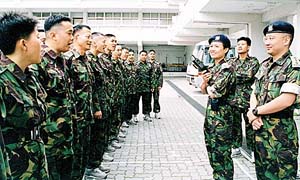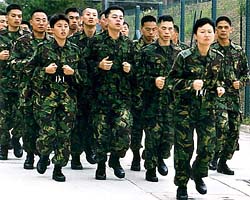



















 Yes Madame! WSP Elsie Wong Mui-kit, PTU's first woman Company Commander briefing members of "Hotel" Company |
BEING the Police Tactical Unit's first woman
Company Commander, a position traditionally regarded as "man's job", WSP Elsie Wong
Mui-kit said the first hurdle that she had to overcome was gaining the acceptance of a large
group of male colleagues who are not used to taking orders from a female commander.
But like most challenges that come her way, the highly disciplined Woman Superintendent Wong, who can finish a 2.4 kilometre run in nine minutes, faces each of life's hurdles head on. |
|
"As you know, not everyone is a believer in the equal capabilities of men and women," she said. "Historically, the Police Tactical Unit has been a man's domain, although ever since women were first admitted to PTU in late 1995 they have been totally accepted. Even so, as its first woman Company Commander I have to do more than a male Company Commander has to in order to remove this 'psychological barrier". "I demonstrate my leadership by example and participation. Showing concern to my colleagues is also important because this lets them know I care about them," continued WSP Wong, who commands PTU's "Hotel" Company. "It's been: 'So far, so good'." Judging by the response of her male colleagues, WSP Elsie Wong Mui-kit has done very well in breaking through PTU's barrier of major machismo. This is how male members of "Hotel" Company (one of PTU's 12 Companies) described their leader: "She is confident and fair, tough and decisive - but also has the caring and meticulous nature of a woman," said one. Another, impressed by her physical training prowess and credo of leading by example and participation, said: "At PTU there's a lot of pressure to push ourselves to obtain the highest standards. WSP Wong pushes herself right along side her Company members." While all said they "had no problem working with a woman commander as the Force already had many senior posts filled by Women Superintendents." She looks great in an evening gown, too, as was evident at last month's Hong Kong Island Regional Ball. As a PTU Company Commander, Mrs Wong leads 170 officers in the four 41-member platoons that make up "Hotel" Company. A daunting task by anyone's standards, male of female. | |
|
Company Commander Wong has been in her post for two months and encourages all officers - especially women officers - to consider joining PTU sooner than later in order to take advantage of an opportunity that in the past was only open to their male counterparts: superb physical training and learning policing skills and tactics that nowadays are extremely useful, if not essential, to all front-line duties. "For front-line officers, what you do and learn at PTU will definitely boost confidence levels and enhance policing capabilities in terms of anti-riot tactics, crowd management, anti-crime patrol, setting up roadblocks, cordoning scenes, searching suspects and vehicles, apprehending violent/armed criminals and dealing with worst case scenarios," said Mrs Wong. She also urges married woman NCOs not to shy away from PTU duty. "The training may be demanding, but it's also very rewarding," said the wife and mother of two children aged six and 11. "I have my burden too. However, I saw no point in losing such a good opportunity which was resolved by making an 'adjustment' with family members. It involves teamwork." And, according to WSP Wong, the spirit of teamwork is also the most essential aspect of commanding a PTU company. |  Leader of the pack. Company Commander Wong takes "Hotel" Company through an early morning jaunt
|
 WSP Wong demonstrating criminal apprehension techniques |  On the ropes. PTU Company Commander Wong is a firm believer in leading by example |
 Emergency 999 response operator's telset displays a caller's phone number | THE Caller Number Display service has been provided for all 999 operators at Regional Command and Control Centre of Hong Kong Island since early December last year following a month-long trial. |
|
"With the CND system, all incoming telephone numbers can now be seen at 999 operator telsets at RCCC/HKI even in the case of line blocking or call blocking as Hongkong Telecom has provided a blocking override device on all calls to 999," Chief Telecommunications Engineer, Raphael Chiu Yat-sing said. "Optimum public safety is therefore ensured as prompt police action could be given to an emergency call when the incoming number is blocked and the caller in need is unable to tell the location," he said. Nuisance calls which range from children playing with the telephone to people maliciously making hoax calls always tie up 999 lines, detracting from the efficiency of the 999 services and making it difficult for callers of genuine emergencies to gain access. In one case during the trial the RCCC/HKI received over 30 nuisance calls from one telephone. After investigation, officers found that there were two little children dialing 999 repeatedly with their phone's re-dial function. Their parents were asked to correct the behaviour of their children. "It is expected that the number of nuisance calls will drop when callers are aware that their numbers will be displayed on the 999 operators' telsets and the tracing of their number becomes easier," said Mr Chiu, adding that action could be taken against persistent nuisance callers. The cost for RCCC/HKI to install the CND system is about $500,000. Preparations are underway to install the CND system at RCCCs of Kowloon and the New Territories and it is expected that the two RCCCs will have the system by April this year after the upgrade of the telephone system. "RCCC/HKI receives about 2,000 calls per day and only 40 per cent of them are of genuine emergencies. According to the telephone number, the police can also trace the address of nuisance callers with Hongkong Telecom. The Force is also considering the possibility of extending the function of CND to see the address of caller. Since this matter involves the protection of customer information, we are seeking the opinion of the telephone company," said Chief Police Communication Officer, Wong Pak-ling. The introduction of the Caller Number Display is just one of many improvements to the Emergency 999 response to come out of the Working Group set up in February 1996 by the Commissioner of Police to examine the operation of the 999 system, to identify any anticipated problems, and to make recommendations to ensure that the Force continued to provide optimum service to the public. The present service provided to the public is of a very high standard. With nearly 3,000,000 calls a year, the average call is answered in four seconds or less. This compares very favourably with similar jurisdictions overseas where answering times of 15 seconds are regarded as acceptable. | |

![]()
